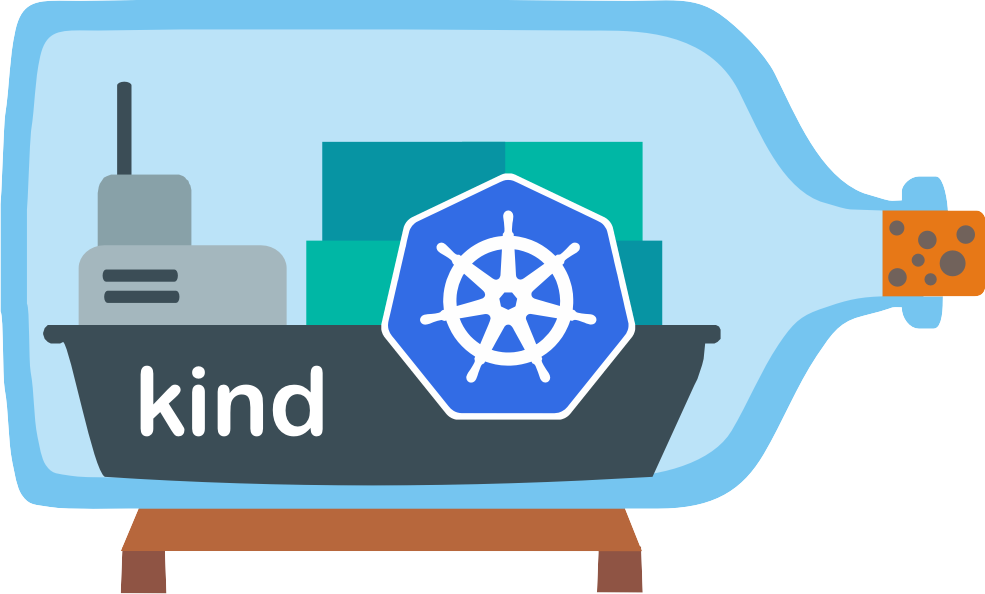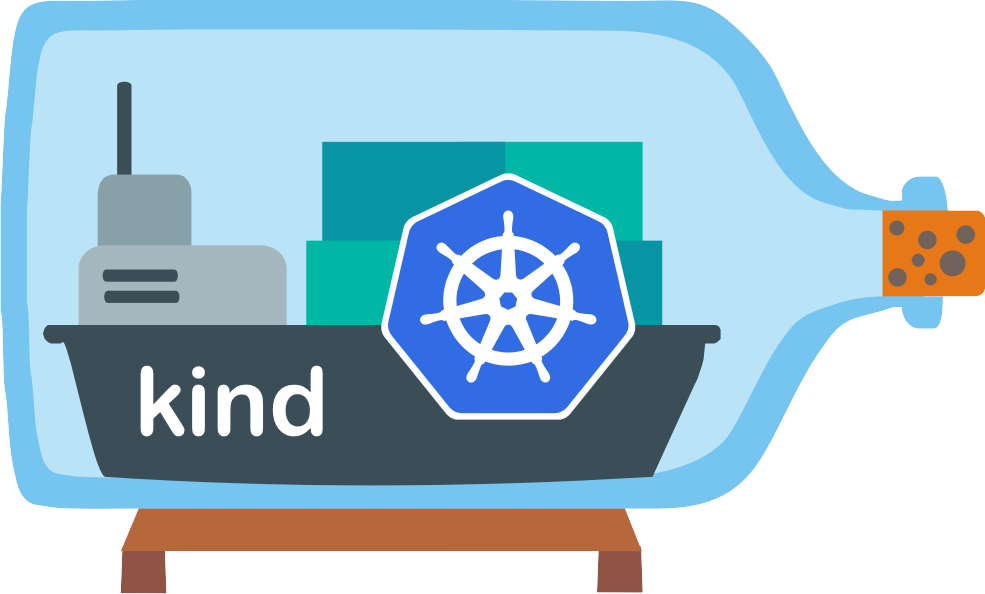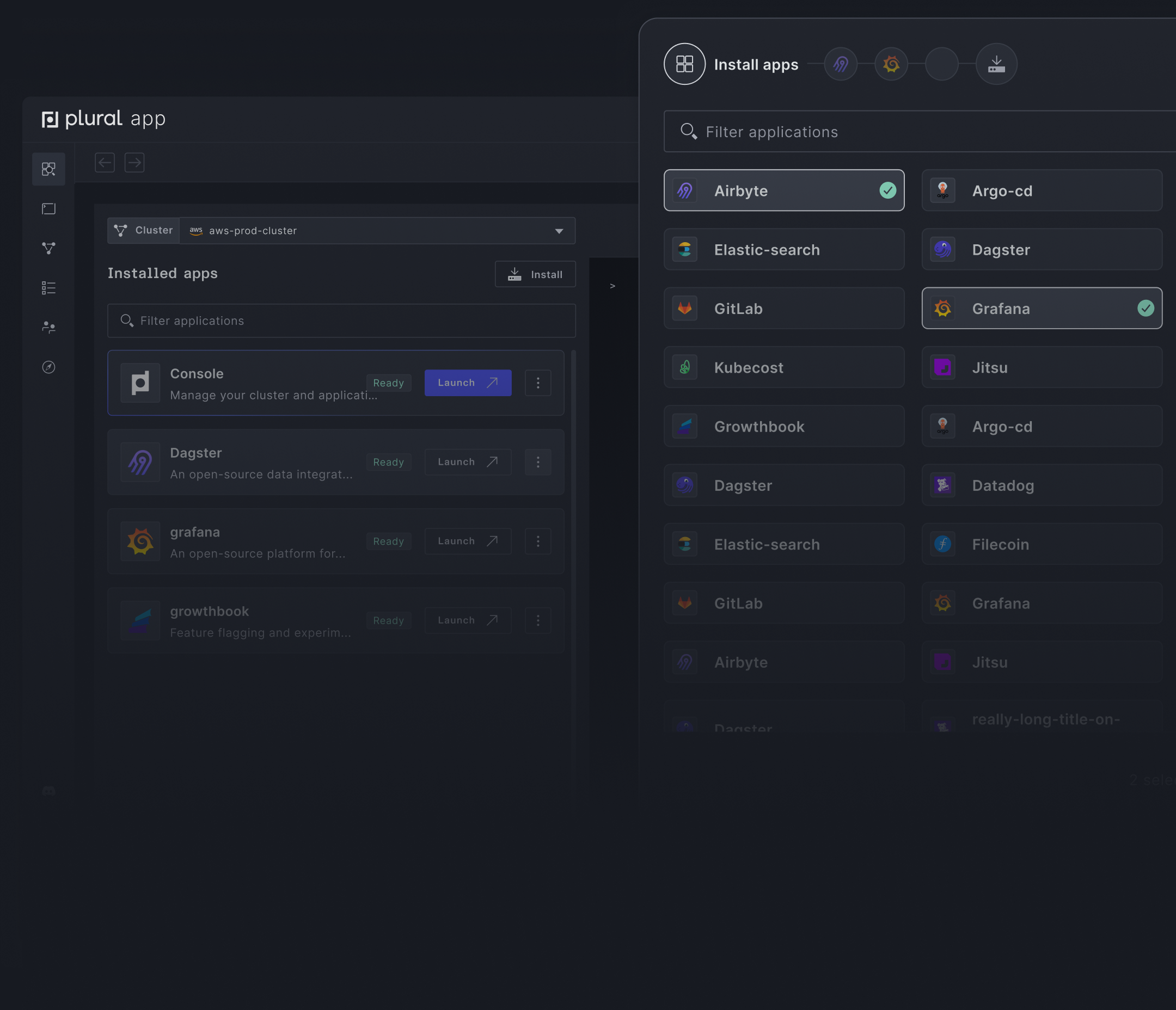Select from 90+ open-source applications
Get any stack you want running in minutes, and never think about upgrades again.


Apache Airflow is an open-source, community-driven platform to programmatically author, schedule and monitor scalable workflows for building machine learning models, transferring data, or managing your infrastructure. It is highly extensible, allowing you to easily define your own operators or re-use existing ones.
Available providers








While anyone with a little Python knowledge can deploy an Airflow workflow, deploying and setting up the application itself is complex and requires specific (cloud) infrastructure, networking, and Kubernetes knowledge.
Plural helps you deploy and manage the lifecycle of open-source applications on Kubernetes. Our platform combines the scalability and observability benefits you get with managed SaaS offerings with the data security, governance, and compliance benefits of self-hosting Airflow.
If you need more than just Airflow, look for other open-source data engineering tools in our marketplace of curated applications to leapfrog complex deployments and get started quickly.
plural bundle install airflow airflow-aws
plural bundle install airflow airflow-azure
plural bundle install airflow airflow-gcp
plural bundle install airflow kind-airflow
plural build
plural deploy --commit "deploying airflow"
Apache Airflow (or simply Airflow) is a platform to programmatically author, schedule, and monitor workflows.
When workflows are defined as code, they become more maintainable, versionable, testable, and collaborative.
Use Airflow to author workflows as directed acyclic graphs (DAGs) of tasks. The Airflow scheduler executes your tasks on an array of workers while following the specified dependencies. Rich command line utilities make performing complex surgeries on DAGs a snap. The rich user interface makes it easy to visualize pipelines running in production, monitor progress, and troubleshoot issues when needed.
Table of contents
Airflow works best with workflows that are mostly static and slowly changing. When the DAG structure is similar from one run to the next, it clarifies the unit of work and continuity. Other similar projects include Luigi, Oozie and Azkaban.
Airflow is commonly used to process data, but has the opinion that tasks should ideally be idempotent (i.e., results of the task will be the same, and will not create duplicated data in a destination system), and should not pass large quantities of data from one task to the next (though tasks can pass metadata using Airflow's XCom feature). For high-volume, data-intensive tasks, a best practice is to delegate to external services specializing in that type of work.
Airflow is not a streaming solution, but it is often used to process real-time data, pulling data off streams in batches.
Apache Airflow is tested with:
| | Main version (dev) | Stable version (2.7.1) | |-------------|------------------------------|------------------------| | Python | 3.8, 3.9, 3.10, 3.11 | 3.8, 3.9, 3.10, 3.11 | | Platform | AMD64/ARM64(*) | AMD64/ARM64(*) | | Kubernetes | 1.24, 1.25, 1.26, 1.27, 1.28 | 1.24, 1.25, 1.26, 1.27 | | PostgreSQL | 11, 12, 13, 14, 15, 16 | 11, 12, 13, 14, 15 | | MySQL | 5.7, 8.0, 8.1 | 5.7, 8.0 | | SQLite | 3.15.0+ | 3.15.0+ | | MSSQL | 2017(**), 2019(**) | 2017(**), 2019(**) |
* Experimental
** Discontinued soon, not recommended for the new installation
Note: MySQL 5.x versions are unable to or have limitations with running multiple schedulers -- please see the Scheduler docs. MariaDB is not tested/recommended.
Note: SQLite is used in Airflow tests. Do not use it in production. We recommend using the latest stable version of SQLite for local development.
Note: Airflow currently can be run on POSIX-compliant Operating Systems. For development, it is regularly
tested on fairly modern Linux Distros and recent versions of macOS.
On Windows you can run it via WSL2 (Windows Subsystem for Linux 2) or via Linux Containers.
The work to add Windows support is tracked via #10388, but
it is not a high priority. You should only use Linux-based distros as "Production" execution environment
as this is the only environment that is supported. The only distro that is used in our CI tests and that
is used in the Community managed DockerHub image is
Debian Bullseye.
Visit the official Airflow website documentation (latest stable release) for help with installing Airflow, getting started, or walking through a more complete tutorial.
Note: If you're looking for documentation for the main branch (latest development branch): you can find it on s.apache.org/airflow-docs.
For more information on Airflow Improvement Proposals (AIPs), visit the Airflow Wiki.
Documentation for dependent projects like provider packages, Docker image, Helm Chart, you'll find it in the documentation index.
We publish Apache Airflow as apache-airflow package in PyPI. Installing it however might be sometimes tricky
because Airflow is a bit of both a library and application. Libraries usually keep their dependencies open, and
applications usually pin them, but we should do neither and both simultaneously. We decided to keep
our dependencies as open as possible (in setup.py) so users can install different versions of libraries
if needed. This means that pip install apache-airflow will not work from time to time or will
produce unusable Airflow installation.
To have repeatable installation, however, we keep a set of "known-to-be-working" constraint
files in the orphan constraints-main and constraints-2-0 branches. We keep those "known-to-be-working"
constraints files separately per major/minor Python version.
You can use them as constraint files when installing Airflow from PyPI. Note that you have to specify
correct Airflow tag/version/branch and Python versions in the URL.
Note: Only
pipinstallation is currently officially supported.
While it is possible to install Airflow with tools like Poetry or
pip-tools, they do not share the same workflow as
pip - especially when it comes to constraint vs. requirements management.
Installing via Poetry or pip-tools is not currently supported.
There are known issues with bazel that might lead to circular dependencies when using it to install
Airflow. Please switch to pip if you encounter such problems. Bazel community works on fixing
the problem in this PR <https://github.com/bazelbuild/rules_python/pull/1166>_ so it might be that
newer versions of bazel will handle it.
If you wish to install Airflow using those tools, you should use the constraint files and convert them to the appropriate format and workflow that your tool requires.
pip install 'apache-airflow==2.7.1' \ --constraint "https://raw.githubusercontent.com/apache/airflow/constraints-2.7.1/constraints-3.8.txt"
pip install 'apache-airflow[postgres,google]==2.7.1' \ --constraint "https://raw.githubusercontent.com/apache/airflow/constraints-2.7.1/constraints-3.8.txt"
For information on installing provider packages, check providers.
Apache Airflow is an Apache Software Foundation (ASF) project, and our official source code releases:
Following the ASF rules, the source packages released must be sufficient for a user to build and test the release provided they have access to the appropriate platform and tools.
There are other ways of installing and using Airflow. Those are "convenience" methods - they are
not "official releases" as stated by the ASF Release Policy, but they can be used by the users
who do not want to build the software themselves.
Those are - in the order of most common ways people install Airflow:
pip tooldocker tool, use them in Kubernetes, Helm Charts, docker-compose, docker swarm, etc. You can
read more about using, customising, and extending the images in the
Latest docs, and
learn details on the internals in the IMAGES.rst document.All those artifacts are not official releases, but they are prepared using officially released sources. Some of those artifacts are "development" or "pre-release" ones, and they are clearly marked as such following the ASF Policy.
DAGs: Overview of all DAGs in your environment.

Grid: Grid representation of a DAG that spans across time.

Graph: Visualization of a DAG's dependencies and their current status for a specific run.

Task Duration: Total time spent on different tasks over time.

Gantt: Duration and overlap of a DAG.

Code: Quick way to view source code of a DAG.

As of Airflow 2.0.0, we support a strict SemVer approach for all packages released.
There are few specific rules that we agreed to that define details of versioning of the different packages:
google 4.1.0 and amazon 3.0.3 providers can happily be installed
with Airflow 2.1.2. If there are limits of cross-dependencies between providers and Airflow packages,
they are present in providers as install_requires limitations. We aim to keep backwards
compatibility of providers with all previously released Airflow 2 versions but
there will sometimes be breaking changes that might make some, or all
providers, have minimum Airflow version specified. Change of that minimum supported Airflow version
is a breaking change for provider because installing the new provider might automatically
upgrade Airflow (which might be an undesired side effect of upgrading provider).Apache Airflow version life cycle:
| Version | Current Patch/Minor | State | First Release | Limited Support | EOL/Terminated | |-----------|-----------------------|-----------|-----------------|-------------------|------------------| | 2 | 2.7.2 | Supported | Dec 17, 2020 | TBD | TBD | | 1.10 | 1.10.15 | EOL | Aug 27, 2018 | Dec 17, 2020 | June 17, 2021 | | 1.9 | 1.9.0 | EOL | Jan 03, 2018 | Aug 27, 2018 | Aug 27, 2018 | | 1.8 | 1.8.2 | EOL | Mar 19, 2017 | Jan 03, 2018 | Jan 03, 2018 | | 1.7 | 1.7.1.2 | EOL | Mar 28, 2016 | Mar 19, 2017 | Mar 19, 2017 |
Limited support versions will be supported with security and critical bug fix only. EOL versions will not get any fixes nor support. We always recommend that all users run the latest available minor release for whatever major version is in use. We highly recommend upgrading to the latest Airflow major release at the earliest convenient time and before the EOL date.
As of Airflow 2.0, we agreed to certain rules we follow for Python and Kubernetes support. They are based on the official release schedule of Python and Kubernetes, nicely summarized in the Python Developer's Guide and Kubernetes version skew policy.
We drop support for Python and Kubernetes versions when they reach EOL. Except for Kubernetes, a version stays supported by Airflow if two major cloud providers still provide support for it. We drop support for those EOL versions in main right after EOL date, and it is effectively removed when we release the first new MINOR (Or MAJOR if there is no new MINOR version) of Airflow. For example, for Python 3.8 it means that we will drop support in main right after 27.06.2023, and the first MAJOR or MINOR version of Airflow released after will not have it.
We support a new version of Python/Kubernetes in main after they are officially released, as soon as we make them work in our CI pipeline (which might not be immediate due to dependencies catching up with new versions of Python mostly) we release new images/support in Airflow based on the working CI setup.
This policy is best-effort which means there may be situations where we might terminate support earlier if circumstances require it.
The Airflow Community provides conveniently packaged container images that are published whenever we publish an Apache Airflow release. Those images contain:
The version of the base OS image is the stable version of Debian. Airflow supports using all currently active
stable versions - as soon as all Airflow dependencies support building, and we set up the CI pipeline for
building and testing the OS version. Approximately 6 months before the end-of-life of a previous stable
version of the OS, Airflow switches the images released to use the latest supported version of the OS.
For example since Debian Buster end-of-life was August 2022, Airflow switched the images in main branch
to use Debian Bullseye in February/March 2022. The version was used in the next MINOR release after
the switch happened. In case of the Bullseye switch - 2.3.0 version used Debian Bullseye.
The images released in the previous MINOR version continue to use the version that all other releases
for the MINOR version used.
Support for Debian Buster image was dropped in August 2022 completely and everyone is expected to
stop building their images using Debian Buster.
Users will continue to be able to build their images using stable Debian releases until the end of life and
building and verifying of the images happens in our CI but no unit tests were executed using this image in
the main branch.
Airflow has a lot of dependencies - direct and transitive, also Airflow is both - library and application,
therefore our policies to dependencies has to include both - stability of installation of application,
but also ability to install newer version of dependencies for those users who develop DAGs. We developed
the approach where constraints are used to make sure airflow can be installed in a repeatable way, while
we do not limit our users to upgrade most of the dependencies. As a result we decided not to upper-bound
version of Airflow dependencies by default, unless we have good reasons to believe upper-bounding them is
needed because of importance of the dependency as well as risk it involves to upgrade specific dependency.
We also upper-bound the dependencies that we know cause problems.
The constraint mechanism of ours takes care about finding and upgrading all the non-upper bound dependencies
automatically (providing that all the tests pass). Our main build failures will indicate in case there
are versions of dependencies that break our tests - indicating that we should either upper-bind them or
that we should fix our code/tests to account for the upstream changes from those dependencies.
Whenever we upper-bound such a dependency, we should always comment why we are doing it - i.e. we should have a good reason why dependency is upper-bound. And we should also mention what is the condition to remove the binding.
Those extras and providers dependencies are maintained in setup.cfg.
There are few dependencies that we decided are important enough to upper-bound them by default, as they are known to follow predictable versioning scheme, and we know that new versions of those are very likely to bring breaking changes. We commit to regularly review and attempt to upgrade to the newer versions of the dependencies as they are released, but this is manual process.
The important dependencies are:
SQLAlchemy: upper-bound to specific MINOR version (SQLAlchemy is known to remove deprecations and
introduce breaking changes especially that support for different Databases varies and changes at
various speed (example: SQLAlchemy 1.4 broke MSSQL integration for Airflow)Alembic: it is important to handle our migrations in predictable and performant way. It is developed
together with SQLAlchemy. Our experience with Alembic is that it very stable in MINOR versionFlask: We are using Flask as the back-bone of our web UI and API. We know major version of Flask
are very likely to introduce breaking changes across those so limiting it to MAJOR version makes sensewerkzeug: the library is known to cause problems in new versions. It is tightly coupled with Flask
libraries, and we should update them togethercelery: Celery is crucial component of Airflow as it used for CeleryExecutor (and similar). Celery
follows SemVer, so
we should upper-bound it to the next MAJOR version. Also, when we bump the upper version of the library,
we should make sure Celery Provider minimum Airflow version is updated.kubernetes: Kubernetes is a crucial component of Airflow as it is used for the KubernetesExecutor
(and similar). Kubernetes Python library follows SemVer,
so we should upper-bound it to the next MAJOR version. Also, when we bump the upper version of the library,
we should make sure Kubernetes Provider minimum Airflow version is updated.The main part of the Airflow is the Airflow Core, but the power of Airflow also comes from a number of providers that extend the core functionality and are released separately, even if we keep them (for now) in the same monorepo for convenience. You can read more about the providers in the Providers documentation. We also have set of policies implemented for maintaining and releasing community-managed providers as well as the approach for community vs. 3rd party providers in the providers document.
Those extras and providers dependencies are maintained in provider.yaml of each provider.
By default, we should not upper-bound dependencies for providers, however each provider's maintainer might decide to add additional limits (and justify them with comment).
Want to help build Apache Airflow? Check out our contributing documentation.
Official Docker (container) images for Apache Airflow are described in IMAGES.rst.
More than 400 organizations are using Apache Airflow in the wild.
Airflow is the work of the community, but the core committers/maintainers are responsible for reviewing and merging PRs as well as steering conversations around new feature requests. If you would like to become a maintainer, please review the Apache Airflow committer requirements.
Yes! Be sure to abide by the Apache Foundation trademark policies and the Apache Airflow Brandbook. The most up-to-date logos are found in this repo and on the Apache Software Foundation website.
If you would love to have Apache Airflow stickers, t-shirt, etc. then check out Redbubble Shop.
The CI infrastructure for Apache Airflow has been sponsored by:
We make it easy to securely deploy and manage open-source applications in your cloud.
Get any stack you want running in minutes, and never think about upgrades again.
You control everything. No need to share your cloud account, keys, or data.
Built on Kubernetes and using standard infrastructure as code with Terraform and Helm.
Interactive runbooks, dashboards, and Kubernetes api visualizers give an easy-to-use toolset to manage application operations.

Build your custom stack with over 90+ apps in the Plural Marketplace.
We no longer needed a dedicated DevOps team; instead, we actively participated in the industrialization and deployment of our applications through Plural. Additionally, it allowed us to quickly gain proficiency in Terraform and Helm.

I have neither the patience nor the talent for DevOps/SysAdmin work, and yet I've deployed four enterprise-caliber open-source apps on Kubernetes... since 9am today. Bonkers.

This is awesome. You saved me hours of further DevOps work for our v1 release. Just to say, I really love Plural.

Wow! First of all I want to say thank you for creating Plural! It solves a lot of problems coming from a non-DevOps background. You guys are amazing!

We have been using Plural for complex Kubernetes deployments of Kubeflow and are excited with the possibilities it provides in making our workflows simpler and more efficient.

Plural has been awesome, it’s super fast and intuitive to get going and there is zero-to-no overhead of the app management.

How to set up a fresh Kubernetes cluster and install Airflow onto that cluster using Plural.

Plural is open-source and self-hosted. You retain full control over your deployments in your cloud. We perform automated testing and upgrades and provide out-of-the-box Day 2 operational workflows. Monitor, manage, and scale your configuration with ease to meet changing demands of your business. Read more.
We support deploying on all major cloud providers, including AWS, Azure, and GCP. We also support all on-prem Kubernetes clusters, including OpenShift, Tanzu, Rancher, and others.
No, Plural does not have access to any cloud environments when deployed through the CLI. We generate deployment manifests in the Plural Git repository and then use your configured cloud provider's CLI on your behalf. We cannot perform anything outside of deploying and managing the manifests that are created in your Plural Git repository. However, Plural does have access to your cloud credentials when deployed through the Cloud Shell. Read more.












